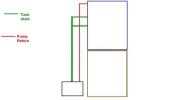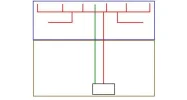I found a 135 gallon for the dirt on craigslist to replace my current 135 that has bad glass but like my current tank, it is not drilled for an overflow. I was originally going to use a siphon overflow box but everyone has told me to drill it instead and the more I read about the siphon overflows, the more I am thinking of drilling. Again I will reiterate that this terrifies the living hell out of me :-) and if I could find someone to drill it for me I would gladly pay them, but no one will touch it. Soooooo as they say no balls, no babies. Screw it I'm going to drill it myself.
I need some advice on overflows in regards to placement, size and flow.
I have been looking at the following kits:
1500 gph flow kit. Would this be sufficient? If so, where would the best placement be? Center? Corner? 1500 gph complete kit - Glass-Holes.com dope aquarium stuff
Or, would two 700 gph kits be better? 700 gph Overflow complete kit - Glass-Holes.com dope aquarium stuff Again, where to place them? I assume I would have one in each corner.
I have also been contemplating building my own sump, but I'm not sure what size tank to use. I have seen some articles saying a 20 gallon tank is sufficient while I have seen others that say you have to have a 55 gallon tank. I will also be running a berlin triple pass skimmer and a uv filter as well. However I have been looking into buying a sump as well and was considering this unit WET DRY FILTER 200 GALLON REEF TANK AQUARIUM - eBay (item 380194205264 end time Feb-03-10 07:17:12 PST) I'm trying to find a happy balance between cost and quality so I can have money to splurge on live rock.
Thoughts, suggestions, alternatives?
Thanks in advance!
I need some advice on overflows in regards to placement, size and flow.
I have been looking at the following kits:
1500 gph flow kit. Would this be sufficient? If so, where would the best placement be? Center? Corner? 1500 gph complete kit - Glass-Holes.com dope aquarium stuff
Or, would two 700 gph kits be better? 700 gph Overflow complete kit - Glass-Holes.com dope aquarium stuff Again, where to place them? I assume I would have one in each corner.
I have also been contemplating building my own sump, but I'm not sure what size tank to use. I have seen some articles saying a 20 gallon tank is sufficient while I have seen others that say you have to have a 55 gallon tank. I will also be running a berlin triple pass skimmer and a uv filter as well. However I have been looking into buying a sump as well and was considering this unit WET DRY FILTER 200 GALLON REEF TANK AQUARIUM - eBay (item 380194205264 end time Feb-03-10 07:17:12 PST) I'm trying to find a happy balance between cost and quality so I can have money to splurge on live rock.
Thoughts, suggestions, alternatives?
Thanks in advance!


